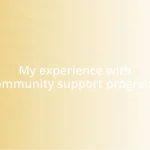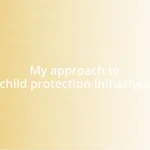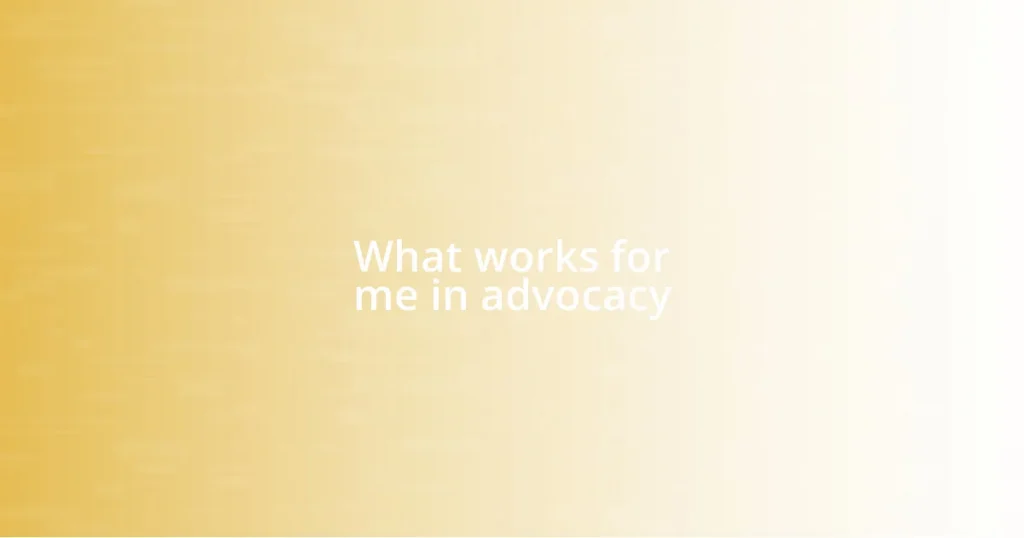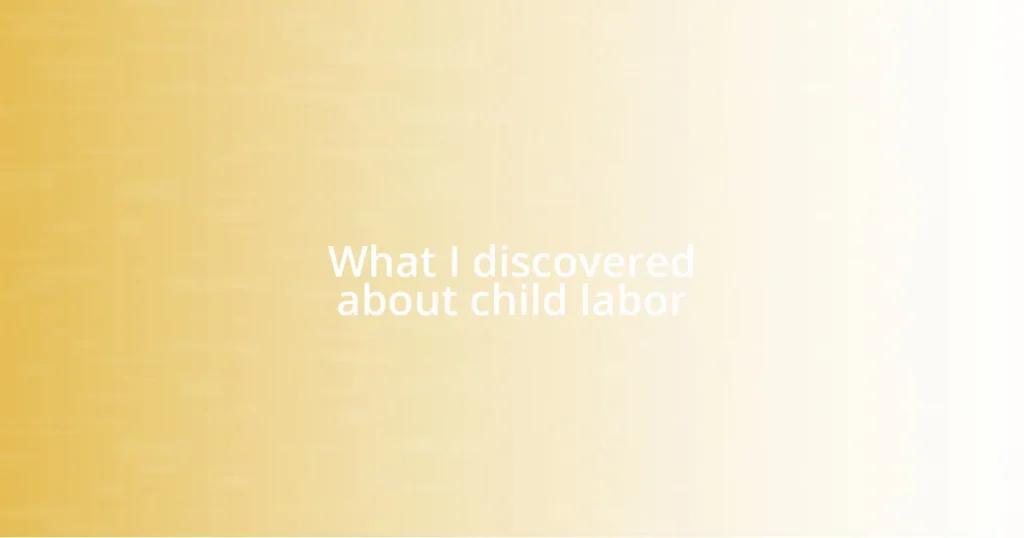Key takeaways:
- Child rights advocacy centers on amplifying children’s voices and ensuring their rights to education and safety are upheld.
- Early experiences with injustice inspired a lifelong commitment to child advocacy, emphasizing the importance of understanding children’s struggles.
- Navigating bureaucratic challenges, ensuring authentic representation of children’s voices, and fostering community engagement are critical hurdles in advocacy.
- Effective strategies include cultivating empathy, collaborating with local organizations, and leveraging social media to raise awareness and engage the community.

Understanding child rights advocacy
Child rights advocacy is fundamentally about ensuring that every child can exercise their rights and live a life free from harm. I remember when I first learned about the United Nations Convention on the Rights of the Child as a child myself; it struck me how these principles were designed to protect kids like me. It made me realize that advocacy isn’t just legal jargon—it’s about real kids, with real dreams and struggles.
When I engage with others on this topic, I often ask, “What does it really mean to protect a child’s right to education, to be heard, or to live in a safe environment?” Reflecting on my experiences in community workshops, I’ve seen firsthand how vital it is to listen to children’s voices. These voices are often overlooked, yet they hold the key to understanding their needs and rights. By advocating for children, we are championing their right to express themselves, which I believe is a powerful foundation for any thriving society.
Through various initiatives, I’ve witnessed the transformative impact of advocacy work, not just in policy change but also in shifting community attitudes toward children’s rights. For example, I participated in a campaign where we shared stories of local children who overcame adversity—seeing their resilience was incredibly moving. It reminded me that child rights advocacy isn’t a one-way street; it thrives on collaboration, empathy, and a shared commitment to uplift the youngest among us. Why wouldn’t we invest in their future?

My early experiences and motivations
Reflecting on my early experiences, I find that the seeds of my passion for child rights were planted during my childhood encounters with injustice. I vividly recall a neighbor’s child who was denied the opportunity to attend school due to financial constraints. Watching that little girl standing by the gate, longing for the education that was just out of reach, filled my heart with a sense of urgency that I could not ignore. It inspired me to speak out, even as a child, making me realize that even small actions could spark change.
- Witnessed a peer being denied education due to family issues.
- Participated in school fairs that taught us about children’s rights.
- Shared stories around the dinner table about kids growing up in tough conditions.
- Joined local community groups advocating for better access to education.
These moments ignited a fire within me. They became the emotional fuel that drives my advocacy today. The importance of standing up for every child’s right to thrive became not just a concept for me, but a heartfelt mission grounded in understanding their struggles and aspirations. My early encounters taught me that advocacy is rooted in connection—understanding the experiences that shape a child’s life enables us to foster real change.

Key challenges faced in advocacy
Key challenges faced in advocacy can sometimes feel overwhelming, even disheartening. One major challenge I encountered was navigating the bureaucratic labyrinth of policies and regulations. There were moments during my early advocacy days when I became so frustrated with the red tape that I questioned whether every hour spent was worth the outcome. But perseverance became my ally. Dealing with complex system changes isn’t just about knowing the rules; it’s about forging connections and understanding the people behind those policies. I learned that patience and persistence often yield the most meaningful change.
Another significant hurdle was ensuring authentic representation of children’s voices in advocacy efforts. I distinctly remember a workshop where I invited several young advocates to share their stories, only to find that many adults still talked over them. That experience opened my eyes to how easily children’s perspectives can become sidelined, despite our best intentions. Advocacy is only impactful when the true needs and thoughts of children are put front and center. I made it my mission to amplify those voices, often finding myself reflecting on how I could create spaces for kids to feel safe and heard.
Lastly, I faced the challenge of building community awareness and engagement. I recall organizing a local event to discuss children’s rights, thinking it would attract a crowd. To my surprise, only a handful showed up. This experience taught me about the importance of meeting people where they are—understanding their interests and values. Advocacy isn’t just about presenting facts; it’s about resonating with people’s hearts and minds. I realized that passion for change must extend beyond just my personal drive; it requires a collective commitment from the community.
| Challenge | Description |
|---|---|
| Bureaucratic Obstacles | Navigating complex policies and regulations can feel like an uphill battle, often requiring persistence and perseverance. |
| Representation of Children’s Voices | Ensuring kids’ perspectives are genuinely heard is essential, and sometimes difficult as adults may unintentionally overshadow their input. |
| Community Engagement | Building awareness and rallying community support is crucial, but it takes effort to resonate with diverse audiences and create meaningful connections. |

Effective strategies for child advocacy
Cultivating empathy is one of the most effective strategies for child advocacy. I often find that when I share personal stories of the children I’ve met—those facing daily struggles—empathy blooms. Once, during a community meeting, I spoke about a young boy who had to care for his siblings instead of attending school. You could feel the room shift; suddenly, those present were experiencing his challenges, laying the groundwork for genuine support and action.
Another powerful approach is collaborating with local organizations that align with your advocacy goals. I recall partnering with a small nonprofit that worked closely with at-risk youth. By combining our resources and expertise, we launched a mentorship program that inspired countless children. It’s a poignant reminder that advocacy isn’t a solo endeavor; it thrives on unity and shared visions, amplifying each voice involved.
Lastly, using social media as a platform for awareness can be transformative. I remember posting about a campaign for equitable access to education and was taken aback by the overwhelming response. People began sharing their own stories, fostering a community of support and advocacy in the comments section. It made me realize just how engaged people want to be—if we invite them in. How can we harness this energy? By consistently sharing impactful stories, statistics, and calls to action, we can turn passive observers into active champions for children’s rights.

Building coalitions and partnerships
Building coalitions and partnerships has been a transformative aspect of my journey as an advocate for children’s rights. I vividly recall a time when I organized a roundtable discussion, bringing together educators, community leaders, and parents. Initially, I was nervous—what if nobody wanted to collaborate? But as we shared our goals and challenges, something incredible happened. The energy in the room changed. We found common ground, and suddenly, it became clear that our diverse perspectives could create impactful solutions for the children we all cared about.
In another instance, I approached a local business to discuss how they could support our literacy programs. To my surprise, they were eager to help, not just with funding, but also by providing volunteers who were passionate about reading. This experience showed me that building partnerships often requires stepping outside my comfort zone. I learned that advocacy is about nurturing relationships—investing time and effort to show others that we’re in this together. What can we achieve if we truly unite our strengths?
Moreover, I found that creating coalitions goes beyond just networking; it’s about fostering trust and mutual respect. In one collaborative project, I faced skepticism from a potential partner who had been burned in previous initiatives. Instead of pushing, I took the time to listen to their concerns and shared my own experiences of setbacks. That conversation not only broke down barriers but also laid a foundation for a partnership built on transparency and shared goals. It’s these connections that empower us to ignite change, reminding me that every collaborative effort carries the potential for genuine impact.















